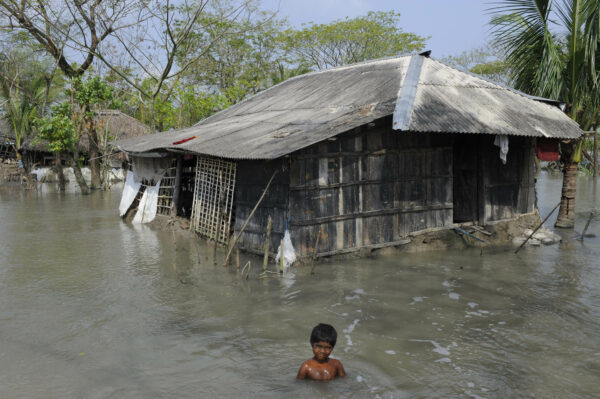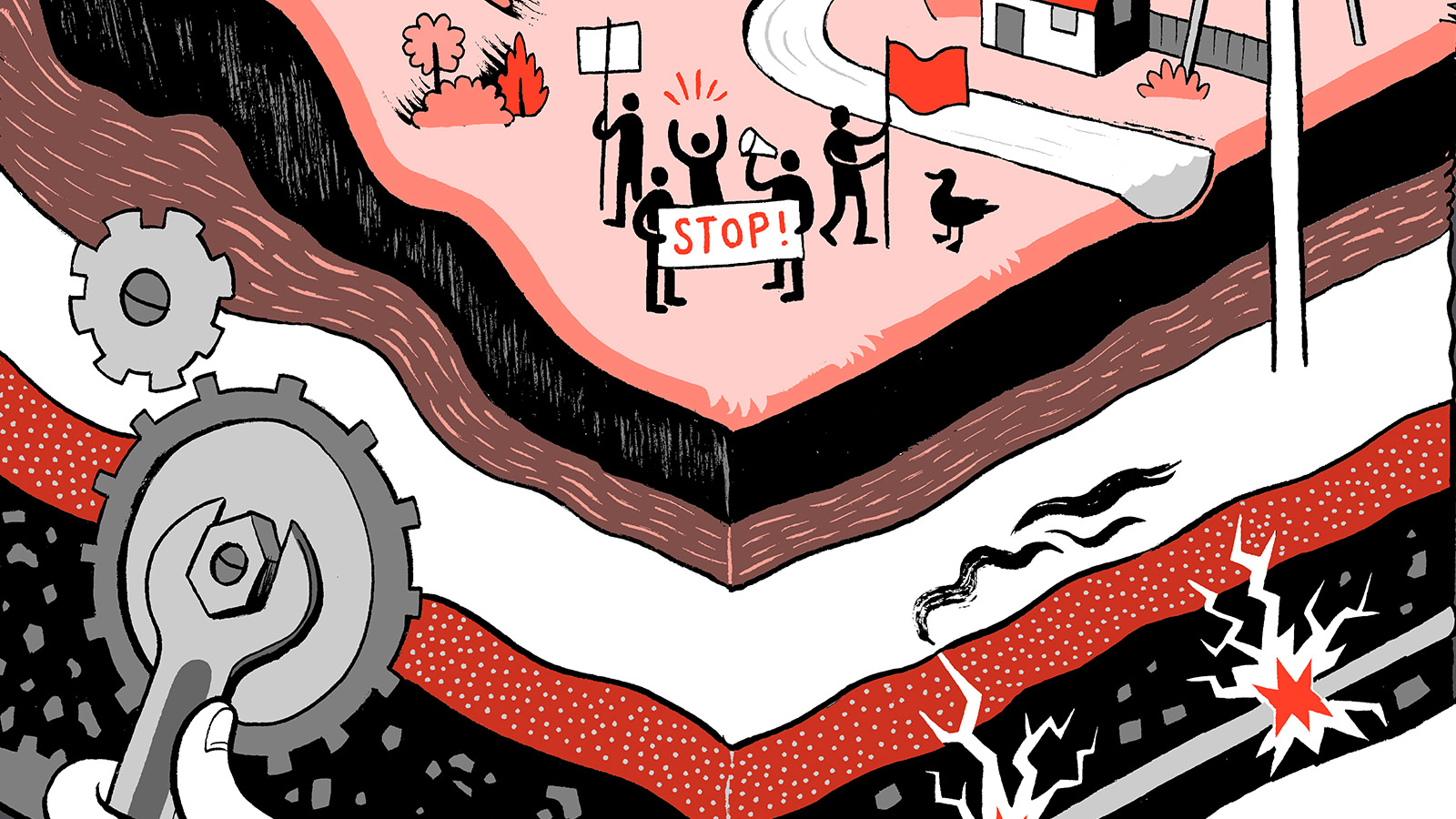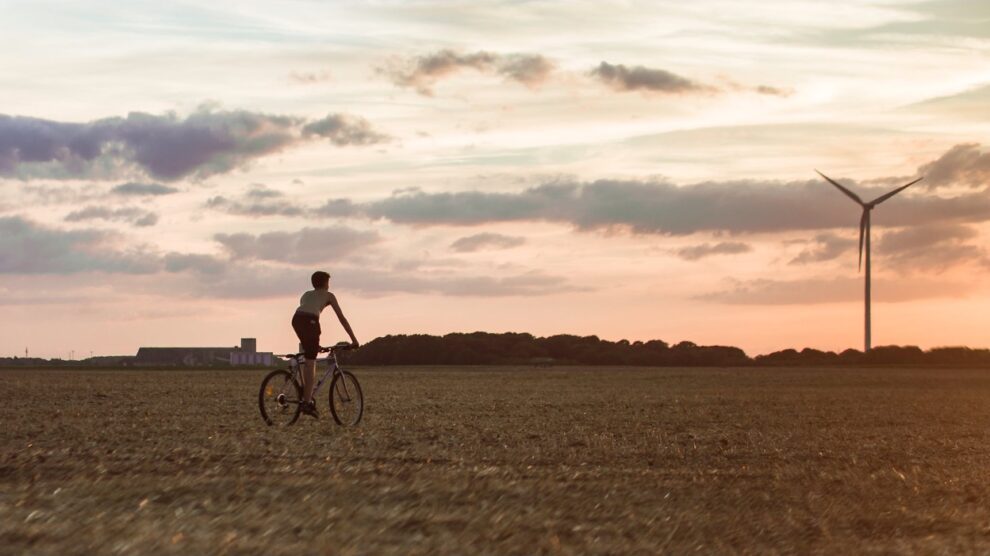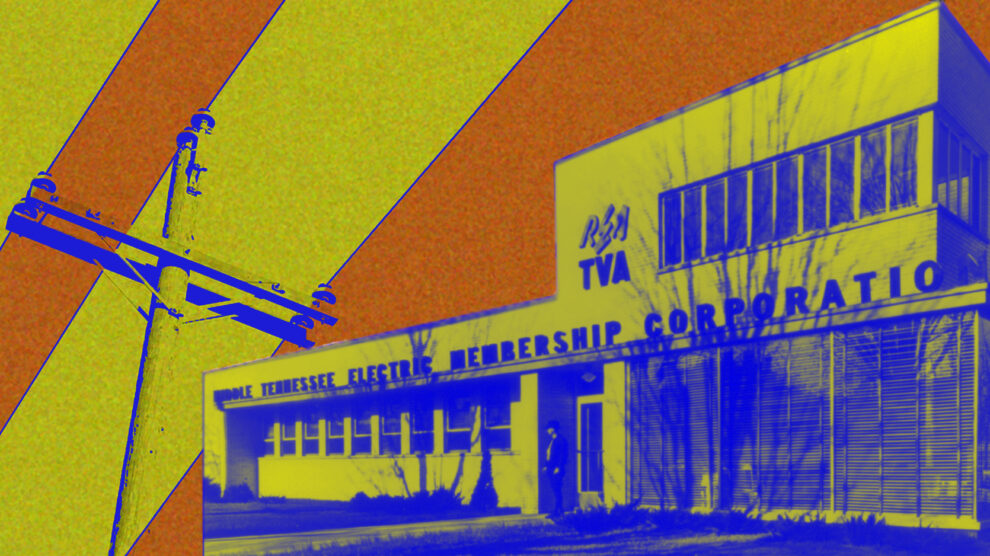No Country for Climate Refugees: How Governments Have Failed Frontline Communities
By Matthew Moss
Volume 23, number 2, A People’s Green New Deal
The winds are howling outside of your window. The walls shake, and you fear the roof over your head will be blown away. It’s the only thing protecting you and everything you own from the torrential rains, otherwise nourishing for life on the island, but hell-bent on destruction in this storm. This lasts only a day, and now everything you know as normal is gone. Your local infrastructure is destroyed. You’ll have to walk miles in order to purchase food, which will be expensive and in short supply. You’ll have to drink water from local rivers, hoping it’s safe just because the water doesn’t look dirty. What do you do?
For survivors like Karen Gonzales, this surreal and terrifying story is no hypothetical, and stories like it will become an even more common reality in the coming years. It won’t just be hurricanes, though. Severe weather, the likes of which haven’t been seen in recent human history, will become the norm. Extreme heat, droughts, wildfires—these will all be a part of our everyday realities as the effects of climate change become increasingly severe. The effects of climate change, both as geopolitical and individual problems, have made it clear that the solutions need to be fought for at the community and governmental level. By understanding the threat of climate change and the bad actors who seek to exploit it, we can better tackle our global climate crisis and help the people displaced and immiserated by it. This will allow us to create a roadmap of how to respond with solidarity and broad scale political change.
The Problem We Face
Scientists say that if we do not drastically cut carbon emissions to 50 percent by 2030 and to net zero by 2050, we will be on an irreversible path towards global temperature increases of greater than 1.5 degrees Celsius.1 While this is true, it obscures the fact that climate change is already here, and we are grossly unprepared to deal with what it means for the people who experience its consequences. Often, those who live in frontline communities are from marginalized and lower income backgrounds, have limited resources to deal with climate catastrophe, and will experience the effects of climate change in the earliest and most severe ways.
Climate change is already devastating these communities in unique ways, depending on their geographical locations. In Bangladesh, impoverished people in rural areas are experiencing extreme flooding and land erosion, leading to increased migration towards higher land.2 In the southwestern United States, such as in Arizona and Nevada, periods of extreme heat have become the norm. During the summer of 2019, these states endured long stretches of temperatures over 110 degrees Fahrenheit.3 These high temperatures affect people who are homeless or cannot afford adequate temperature control systems in their homes.
As these new, extreme weather patterns become more common, they will make it impossible for people to remain where they currently live. The term “climate refugees” is often used to describe individuals who have been forced to abandon their homes due to disasters caused by climate change. While the United Nations High Commissioner for Refugees does not endorse the term, preferring instead the phrase, “persons displaced in the context of disasters and climate change,” it does recognize that (1) climate change and its related problems are causing the displacement, and (2) those displaced are going to require support from both the regions they escape from and the regions they migrate to.4
A 2020 paper by Caleb Robinson and colleagues modelled the effects of rising sea levels on movement from US coastal populations and found substantial migration out of these areas is likely to occur.5 They predict that much of this migration would be from cities on the East Coast to nearby inland states, and also to the Midwest. This article’s discussion of the direction of migration away from coastal communities is interesting; however, it doesn’t discuss the effects on people who are unable to escape. Several coastal cities contain areas with extremely high levels of poverty. How will the survivors afford to move? And if they can’t, will they be able to survive?
Government responses to climate events in their own country have been inadequate. The response to the recent devastating storms in Puerto Rico is a perfect example of such inadequacy: a response which, to put it bluntly, left the poorest people to die. Hurricane Irma was a Category 5 storm that hit the Caribbean in September 2017. It was followed two weeks later by Hurricane María, another Category 5 storm. The back-to-back damage of these storms on the region was devastating, with a total death toll of nearly three thousand people across the Caribbean.6 These effects were strongly felt in Puerto Rico by citizens such as Karen Gonzales, who was twenty years old when the storms struck.
A Case Study: Living Our Failure In Puerto Rico
While nominally an unincorporated territory of the United States, Puerto Rico is treated as a colonial outpost. The economy of this island has been ruined by businesses within the contiguous United States, leading to disrepaired infrastructure and high levels of poverty (43 percent of people there live below the poverty line as of 2018).7 In 2017, Puerto Rico provided an opportunity to see how governments could help frontline communities deal with the impacts of climate change, and how they will inevitably fail if they continue with their current attitude and policies.
The lives of Puerto Ricans were completely upended by the back-to-back storms. In an interview with Science for the People, Karen described total devastation in the parts of the island outside of urban centers like San Juan; in 2018, approximately 6.4 percent of the population lived outside of these urban centers.8 When the storms hit, Karen was living in Barrio Pasto within the town of Morovis, located in the beautiful mountains of Puerto Rico. She described how the storm destroyed the two roads that connected her town to food and water supplies in the nearest city.. Electrical infrastructure was also knocked out. The most basic things that people relied on to survive were rapidly taken away from them.
Even in the midst of all this suffering, there was always the lingering hope that soon the Federal government would send food, water, and other resources. That help never came. The Trump administration held back supplies and financial aid. They later prevented other countries from sending aid by not lifting the Jones Act, a law that requires all goods sent between areas in the United States to be sent on ships made and owned in the US.9 While the effects of this law had already been integrated into the day-to-day living in Puerto Rico, it prevented critical emergency aid from reaching the island and greatly increased the cost of the materials that could be purchased. This prevented poor Puerto Ricans from being able to rebuild after the destruction of their homes.
Needless to say, people were enraged by this response. Karen described the anger that she and her community felt as they suffered at the hands of the colonizers’ regulations (Puerto Rico not only has all of its imports controlled by the United States due to the Jones Act, but it also is unable to control its own finances, which are controlled by a board appointed by politicians in the mainland United States).10 She felt angry that it “wasn’t perceived as an actual emergency” in the government’s response. This is a common failing of the federal government. The responses to Hurricane Katrina in New Orleans in 2005, and in the Bahamas after Hurricane Dorian in 2019, where the United States wouldn’t allow people made homeless to come to the mainland without going through a difficult and expensive process to acquire a visa, exemplify a failure to act, leading to tragic and preventable outcomes.11
The answer to the question of whether these responses were inadequate due to incompetence or racism is complicated (Puerto Rico, New Orleans and the Bahamas all have heavily non-white, low income populations), but it is likely a combination of both. One thing that is certain is that as climate change accelerates, catastrophic climate events will become more frequent and the need for the right response will become more pressing. Our success will depend on the direction in which global powers choose to proceed, and so far governments across the globe have failed us. We’ve seen the Australian government ignore experts as fires burned down the country,12 and we’ve seen the government of Mozambique demand survivors trade sexual favors for food after Cyclone Idai.13 We must ask whether this is all that is possible. Can we do better?
A Call To Action
Many people, including Karen, believe that the way forward is with compassion and solidarity. After Hurricane María, she describes how her family helped their elderly neighbor access supplies and how her whole village “helped each other out, especially to clear the roads.” This allowed them to get more supplies, even as the supply chain was broken down. While seemingly small, actions like these show that it is possible for people to work together to survive catastrophes. Mutual aid has been an important aspect of the fight to help those affected by climate catastrophes, such as in New Orleans where the Common Ground Collective assisted in the recovery after Hurricane Katrina.14 Actions like this go a long way towards helping vulnerable people affected by climate change, and represent one positive model of how we can help people displaced by it.
We’ve also seen other reactions to refugees with tragic outcomes, in addition to the rise of right-wing governance leading to extremely hostile responses. In the United States, this has looked like President Trump demagoging against migrant caravans along the southern border during his election campaign and setting the stage for Immigration and Customs Enforcement (ICE) agents to terrorize migrants attempting to reach America (i.e. by pouring out water in the desert meant to help them survive the long journey).15 In Australia, the government keeps climate refugees incarcerated in offshore prisons.16 In New Zealand, the Christchurch shooter described in his manifesto how immigrants were invaders before shooting dozens of worshippers in a Mosque.17 An even more explicit example of ecofascism occurred in El Paso, Texas, where a shooter said killing immigrants was the “logical step … to decrease the number of people in America using resources.”18
All of these represent one terrifyingly possible global response to the coming migration that will be caused by the climate crisis. People who are displaced will need help from the countries they arrive in, and if governments don’t start providing help, the response will likely look even more like the violence that has already occurred.
The stakes of the climate crisis couldn’t be clearer for the people most affected. Mass displacement will upend the lives of an untold number of people, and the world has not yet decided on a proper way to humanely alleviate the suffering and precarity of their situations. Presently, poor migrants face brutal conditions and unwelcoming destinations, and much of the world seems to be getting worse in their responses to this. It is now time to come together, to ease the pain of those suffering the most and welcome them, instead of beating them down further.
- Nicholas Stern, “We Must Reduce Greenhouse Gas Emissions to Net Zero or Face More Floods,” The Guardian, October 8, 2018, www.theguardian.com/environment/2018/oct/08/we-must-reduce-greenhouse-gas-emissions-to-net-zero-or-face-more-floods.
- Poppy McPherson, “Dhaka: the City Where Climate Refugees Are Already a Reality,” The Guardian, December 1, 2015, www.theguardian.com/cities/2015/dec/01/dhaka-city-climate-refugees-reality.
- Doyle Rice, “The Southwest Is Sizzling: Here’s Where It Is Expected to Hit 115 or More,” USA Today, August 14, 2019, www.usatoday.com/story/news/nation/2019/08/14/southwest-heat-excessive-heat-warnings-for-16-million/2007374001/.
- United Nations, “Climate Change and Disaster Displacement,” UNHCR, www.unhcr.org/climate-change-and-disasters.html.
- Caleb Robinson et al., “Modeling Migration Patterns in the USA under Sea Level Rise,” Plos One 15, no. 1 (2020).
- Ray Sanchez, “How Puerto Rico’s Death Toll Climbed from 64 to 2,975 in Hurricane María,” CNN, August 29, 2018, www.cnn.com/2018/08/29/us/puerto-rico-growing-death-toll/index.html.
- US Census Bureau “More Puerto Ricans Move to Mainland United States, Poverty Declines,” The United States Census Bureau, September 30, 2019, www.census.gov/library/stories/2019/09/puerto-rico-outmigration-increases-poverty-declines.html.
- “Puerto Rico – Rural Population.” Puerto Rico—Rural Population—1960-2018 Data,” Trading Economics, tradingeconomics.com/puerto-rico/rural-population-percent-of-total-population-wb-data.html.
- Matthew Yglesias, “The Jones Act, the Obscure 1920 Shipping Regulation Strangling Puerto Rico, Explained,” Vox, Vox, October 9, 2017, www.vox.com/policy-and-politics/2017/9/27/16373484/jones-act-puerto-rico.
- Kate Aronoff, “As Puerto Rico Erupts in Protests, La Junta Eyes More Power,” The Intercept, July 24, 2019, https://theintercept.com/2019/07/24/puerto-rico-protests-ricardo-rossello-la-junta/.
- Sanya Mansoor, “Bahamian Evacuees Not Allowed to Come to US After Dorian” Time, Time, September 10, 2019, time.com/5672378/bahamas-dorian-survivors-us-visa/.
- Stephen Easton, “‘Ignored and Trivialized’: Experts Warned Australian Government before Catastrophic Blazes,” NBC News, February 9, 2020, https://www.nbcnews.com/news/world/ignored-trivialized-experts-warned-australia-government-catastrophic-blazes-n1132326.
- Al Jazeera and News Agencies, “Mozambique Cyclone Victims ‘Forced to Trade Sex for Food’.’” Al Jazeera, April 25, 2019, www.aljazeera.com/news/2019/04/mozambique-cyclone-victims-forced-trade-sex-food-190425160159439.html.
- “Common Ground Collective—Anarchy in Action,” February 7, 2017, accessed May 28, 2020, https://anarchyinaction.org/index.php?title=Common_Ground_Collective.
- Amy Wang, “Border Patrol Agents Were Filmed Dumping Water Left for Migrants. Then Came a ‘Suspicious’ Arrest,” The Washington Post, January 24, 2018, www.washingtonpost.com/news/post-nation/wp/2018/01/23/border-patrol-accused-of-targeting-aid-group-that-filmed-agents-dumping-water-left-for-migrants/.
- Jeff Sparrow, “Australia’s Orwellian Anti-Refugee System Hints at What’s to Come for Climate Refugees,” The Guardian, July 16, 2019, www.theguardian.com/commentisfree/2019/jul/16/australias-orwellian-anti-refugee-system-hints-at-whats-to-come-for-climate-refugees.
- Alex Ward, “The New Zealand Shooter Called Immigrants ‘Invaders.’ Hours Later, so Did Trump.” Vox, March 15, 2019, www.vox.com/2019/3/15/18267745/new-zealand-mosque-attack-invade-trump.
-
Natasha Lennard, “The El Paso Shooter Embraced Eco-Fascism. We Can’t Let the Far Right Co-Opt the Environmental Struggle.” The Intercept, August 05, 2019, https://theintercept.com/2019/08/05/el-paso-shooting-eco-fascism-migration/.






